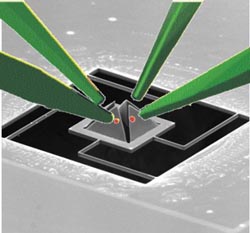Reducing Friction without Oil

Researchers have seen hints before that solids can slide past each other with almost no friction. Now two groups have obtained definitive evidence that ultralow friction occurs between various pairs of materials. One team dragged a microscopic silicon point over a salt crystal; the other slid a tungsten point over a flaky graphite layer. The results, reported in the 26 March and 2 April issues of PRL, imply that researchers might be able to design nano-scale motors or other devices to glide smoothly.
To look at friction up close, imagine putting an atom on the end of a spring and dragging it across a surface. You would feel a repeating pattern of sticking and slipping as the atom was attracted to each surface atom and then must be yanked away to the next one by the stretched spring. Each “yanking” event wastes energy by jostling surface atoms–the familiar effect of friction causing heat.
In the late 1980s researchers at IBM predicted that if the atom were touching the surface gently enough, the stick-slip motion would become smooth sliding. The reason is that with weak interaction between the atom and the surface, the atom could easily be pulled along from one atomic site to the next without much spring stretching. In this regime, the attractions are weak–though not zero–compared with the spring strength, so the atom never remains stuck on the previously visited site. During the 1990s, a Japanese group coined the term “superlubricity” for another type of ultralow friction and claimed to have observed it between a tungsten tip and silicon, but some researchers doubted the experiments.
Now two other material surfaces have yielded evidence of ultralow friction. Ernst Meyer and colleagues at the University of Basel in Switzerland built a custom friction force microscope with a silicon tip capable of resolving very small forces. They measured the horizontal force required to drag the tip a few nanometers per second across the surface of a sodium chloride crystal. When the team reduced the force against the surface sufficiently, they observed the predicted transition from stick-slip to smooth sliding.
Martin Dienwiebel, Joost Frenken, and coworkers at Leiden University in the Netherlands, report they’ve achieved superlubricity by picking up a graphite flake with their unique tungsten-tipped microscope. While testing their “Tribolever” device, which monitors forces on its tip in all three directions, they rotated a graphite sample in small steps. They observed maximum friction at 0 and 60 degrees of rotation, but negligible friction at other angles.
A flake parallel to the surface and stuck to the tip would naturally explain the result, the researchers say. When the atomic rows of one surface sit in the grooves of the other (at 0 and 60 degrees), there is resistance to motion because all the atoms need to simultaneously climb “uphill” against their counterparts in the other surface. At intermediate angles, there is no particular alignment between the atoms, so the resistance from those going “uphill” is cancelled by the extra push received by those heading “downhill.” The frictionless sliding remained even when the team pushed down with the tip. They say the result could explain why graphite lubricant–a spray of randomly oriented flakes–works so well, and why carbon nanotubes nested inside each other spin unexpectedly freely.
“Both papers provide excellent experimental confirmation of the concept of superlubricity between two solid surfaces,” says Mathew Mate of Hitachi Global Storage Technologies in San Jose, CA. There may still be some residual friction in the smooth sliding regimes the two teams observed, he explains, but with such slow sliding, the remaining friction is “immeasurably small.” The results also suggest that micro- and nano-scale motors and other devices could be designed to slide against each other smoothly, he says.
–JR Minkel
JR Minkel is a freelance science writer in New York City.
More Information
2009 interpretation of these data suggests no superlubricity: Phys. Rev. B 80, 235435 (2009)
tutorial on nano-scale friction–see the applet under “Playing Tomlinson” to visualize the stick-slip to sliding transition


